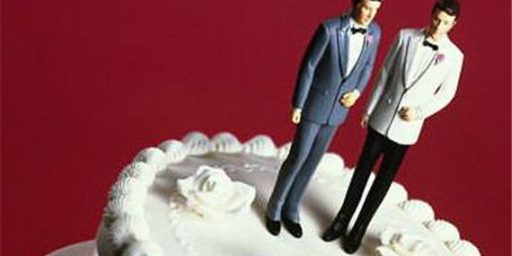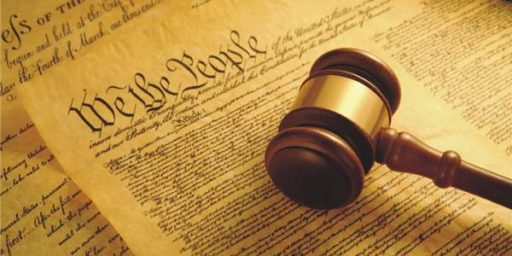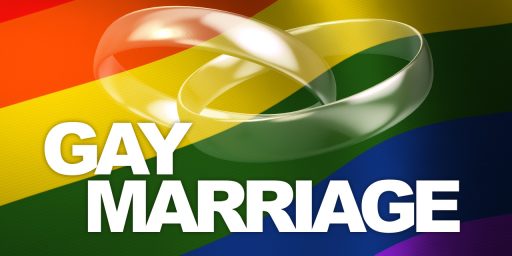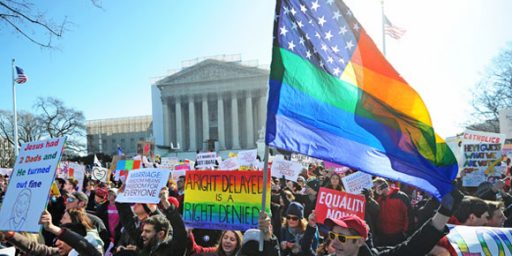Edith Windsor, Plaintiff In Landmark Marriage Equality Case, Dies At 88
Edith Windsor, the Plaintiff whose lawsuit led to the first of two landmark Supreme Court rulings on marriage equality, has died at the age of 88:
Edith Windsor, the gay-rights activist whose landmark case led the Supreme Court to grant same-sex married couples federal recognition for the first time and rights to a host of federal benefits that until then only married heterosexuals had enjoyed, died on Tuesday in Manhattan. She was 88.
Her wife, Judith Kasen-Windsor, confirmed the death, at a hospital, but did not specify a cause. They were married in 2016.
Four decades after the Stonewall Inn uprising fueled the fight for lesbian, gay, bisexual and transgender rights in America, Ms. Windsor, the widow of a woman with whom she had lived much of her life, became the lead plaintiff in what is widely regarded as the second most important Supreme Court ruling in the national battle over same-sex marriage rights.
The Windsor decision, handed down in 2013, was limited to 13 states and the District of Columbia. But in a more expansive ruling in 2015, in Obergefell v. Hodges and three related cases, the Supreme Court held that same-sex couples had a constitutional right to marry anywhere in the nation, with all the protections and privileges of heterosexual couples. Its historic significance was likened to that of Lawrence v. Texas in 2003, which decriminalized gay sex in the United States.
Ms. Windsor had originally gone to court simply to obtain a tax refund. But for thousands struggling for gender equality, the stakes went far beyond tax advantages available to married heterosexuals, including Social Security, health care and veterans’ benefits; protection in immigration and bankruptcy cases; and keeping a home after a spouse had died.
Like countless others, Ms. Windsor had been snared by the Defense of Marriage Act of 1996, which barred same-sex married couples from federal recognition as “spouses,” effectively excluding them from the many federal benefits available to married heterosexuals. (Those benefits numbered 1,138, according to a count by the Government Accountability Office, Congress’s fiscal watchdog agency.)
After living together for 40 years, Ms. Windsor and Thea Spyer, a psychologist, were legally married in Canada in 2007. Dr. Spyer died in 2009, and Ms. Windsor inherited her estate. But the Internal Revenue Service denied her the unlimited spousal exemption from federal estate taxes available to married heterosexuals, and she had to pay taxes of $363,053.
She sued, claiming that the law, by recognizing only marriages between a man and a woman, unconstitutionally singled out same-sex marriage partners for “differential treatment.”
Affirming two lower court rulings, the Supreme Court, in the United States v. Windsor, overturned the law in a 5-4 ruling. It cited the Fifth Amendment guarantee that no person shall be “deprived of life, liberty or property without due process of law.”
The Defense of Marriage Act had been adopted in Congress by wide margins and signed by President Bill Clinton under the pressures of an election year, at a time when gay marriage was illegal across the country and odious to millions of Americans.
By striking down the act’s definition of marriage as a union of a man and a woman, the Supreme Court invalidated the entire law and for the first time granted same-sex marriage partners the recognition and benefits accorded married heterosexuals.
But there was a catch. The decision did not say if there was a constitutional right to same-sex unions, and it left in place laws in 37 states that banned such marriages. As a practical matter, that meant the benefits would not extend to couples in states that did not allow same-sex unions, but only to those in 13 states and the District of Columbia, all of which recognized them.
Gay-rights advocates acknowledged that the ruling had fallen short of their hopes for a constitutional guarantee of nationwide marriage equality. But it was, they said, a crucial step.
(…)
Ms. Windsor was born Edith Schlain in Philadelphia on June 20, 1929, the youngest of three children of James and Celia Schlain, Jewish immigrants from Russia who struggled with poverty during the Great Depression. Their candy store and their home above it were quarantined and lost after Edith and a brother contracted polio when she was 2.
Edie, as family and friends called her, read voraciously and was an excellent student in public schools. In high school during World War II, she dated boys but recalled having crushes on girls. In 1946, she enrolled at Temple University. She became engaged to her brother’s friend Saul Windsor, but broke it off when she fell in love with a female classmate.
“It was wonderful and terrible,” she told Time magazine years later. Deciding that she did not want a lesbian life, however, she reconciled with Mr. Windsor and married him after receiving her bachelor’s degree from Temple in 1950. Less than a year later, they were divorced.
“Finally, I said, ‘Honey, you deserve more,’ ” Ms. Windsor told The New York Times. ” ‘You deserve someone who feels you’re the most desirable person, and I need something else.’ And I was right. He married the right girl and had a lovely life.”
Keeping her married name, she moved to New York, took secretarial jobs and in 1957 earned a master’s degree in applied mathematics from New York University. She also learned computer programming, working for a time on the Univac computer for the Atomic Energy Commission at N.Y.U. She was hired by I.B.M. as a computer programmer in 1958.
Ms. Windsor kept her sexuality secret from her employer and work colleagues and was terrified of exposure when she patronized lesbian hangouts. She met Dr. Spyer in 1963 at a Greenwich Village restaurant, Portofino, that catered to lesbians on Friday nights. Two years younger than Ms. Windsor, Dr. Spyer was a clinical psychologist, an accomplished violinist and a daughter of prosperous Dutch refugees.
They danced all night, and they saw each other at parties over the next two years. But it was not until 1965, after meeting again in the Hamptons, that they began dating.
In 1967, Dr. Spyer proposed marriage, and they began what became a 40-year engagement, sealed with a diamond brooch — not a ring, which might have raised questions and given them away.
As their careers flourished, they shared an apartment in Greenwich Village on lower Fifth Avenue, near Washington Square Park; bought a small house in Southampton, N.Y.; traveled to Europe and South America; entertained gay and lesbian friends at dinner parties, and enjoyed the city’s rich cultural life. Returning from a trip to Italy in 1969, they learned that the Stonewall Inn uprising had occurred the night before.
“Until then, I’d always had the feeling — and I know it’s ignorant and unfair — ‘I don’t want to be identified with the queens,’ ” Ms. Windsor told NYU Alumni Magazine in 2011. “But from that day on, I had this incredible gratitude. They changed my life. They changed my life forever.”
Ms. Windsor and Dr. Spyer marched in gay pride parades with rainbow flags, joined gay and lesbian organizations and lived openly as lesbians. In 1975, when I.B.M. moved her group out of the city, Ms. Windsor took early retirement as a senior systems programmer and began what she called a second career as an L.G.B.T.-rights activist.
(…)
In 1993, when New York City began a domestic partnership registry to extend housing, health insurance and other benefits to gays, lesbians and unmarried heterosexuals, Ms. Windsor and Dr. Spyer were among the first to sign up.
And marriage was still their hope in 2002, when Dr. Spyer had a heart attack, and in 2007, when doctors said she had only a year to live. With time running out, they traveled to Toronto with six friends and were married in a ceremony conducted by Canada’s first openly gay judge. It was later recognized as a valid marriage by New York State.
“Married is a magic word,” Ms. Windsor told a rally outside City Hall in New York a few days before Dr. Spyer, a quadriplegic, died on Feb. 5, 2009. “And it is magic throughout the world. It has to do with our dignity as human beings, to be who we are openly.”
Same-sex marriage became valid in New York State in 2011, too late for Ms. Windsor and Dr. Spyer. But Ms. Windsor’s 2013 Supreme Court victory was followed by an avalanche of lawsuits attacking same-sex marriage bans in jurisdictions where they remained. And on June 26, 2015, the Supreme Court made same-sex marriage a constitutional guarantee all over the land.
(…)
On the day of the 2015 ruling, Ms. Windsor gave a celebratory party. “I’m thrilled, I’m absolutely thrilled,” she told The New Yorker as guests crowded her apartment.
But, she added: “I think it’s only the next major step. We have a history: beginning to see each other with Stonewall, when a whole new community began to recognize itself; the AIDS crisis — we’d always been separated. Gays and lesbians, separated!”
The party fell silent when President Obama appeared on television and hailed “the countless small acts of courage of millions of people across decades who stood up” for gay rights.
“Sometimes,” he said, “there are days like this when that slow, steady effort is rewarded with justice that arrives like a thunderbolt.”
The Times obituary misstates the nature of Windsor’s case just slightly. As noted, the only question before the Supreme Court was whether the Defense of Marriage Act was unconstitutional, the constitutionality of state law bans was not an issue at all and none of the then-existing state laws would have been impacted regardless of what the Court said in the case. Despite that, United States v. Windsor was an important step on the road that led to Obergefell v. Hodges two years later because it became the basis upon which numerous Federal Courts would hold that state laws were unconstitutional in subsequent rulings that ultimate set in motion the chain of events that led to where we are today. Whether or not Justice Kennedy intended it when he wrote the Windsor opinion, his language became the basis upon which those rulings were based and ultimately led to Kennedy’s landmark ruling in Obergefell. And, to a great extent, it all started because of Edith Windsor.




